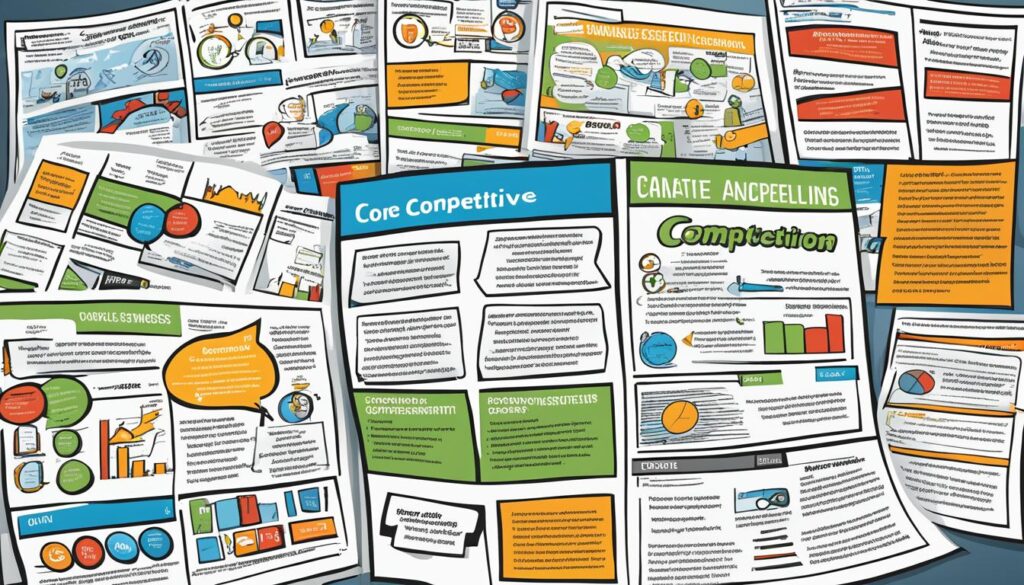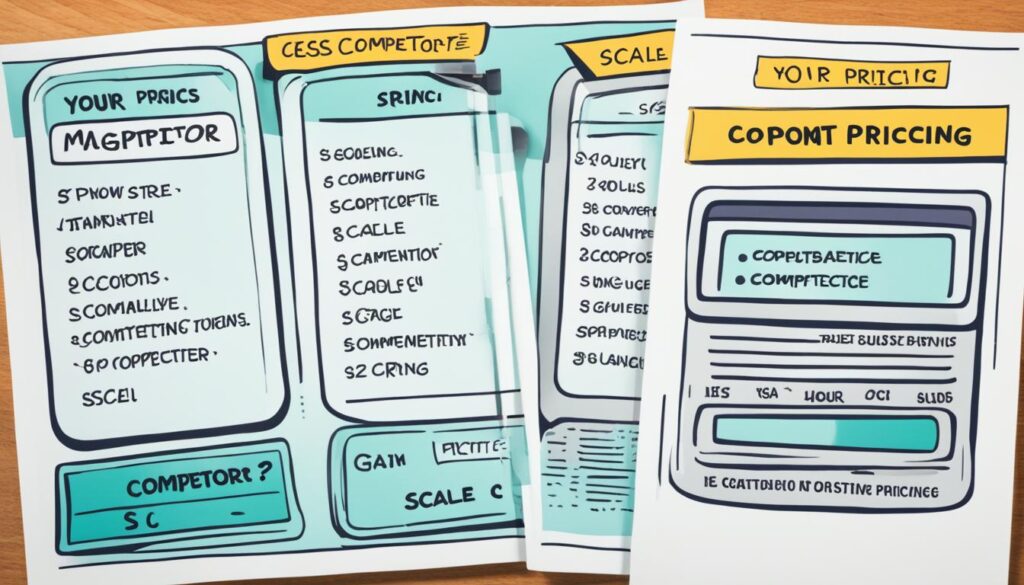95% of businesses consider competitor analysis essential for strategic planning. It is crucial to staying ahead and unlocking your company’s potential. A comprehensive analysis can assist you in outperforming the competition.
Competitive analysis involves gathering data about rivals’ products, sales, and marketing strategies. This information helps identify strengths, weaknesses, and opportunities. It provides insights into the market landscape.
With this knowledge, you can make smart decisions to improve your industry position. Regular analysis keeps you ahead of the curve.
Key Takeaways
- Competitor analysis is a crucial part of strategic planning for 95% of businesses.
- A competitive analysis helps you identify your company’s strengths, weaknesses, and potential opportunities.
- Conducting a competitive analysis can provide valuable insights into the market landscape and guide your business strategy.
- Regularly revisiting your competitor analysis is essential to stay ahead of the curve.
- Leveraging competitive intelligence can give your business a significant advantage in the market.
What Is a Competitive Analysis?
A competitive analysis gathers data about your competitors’ products, sales, and marketing strategies. It helps businesses identify strengths, weaknesses, and opportunities. This analysis provides insights into the market landscape and your position relative to rivals.
Josh Rovner, a business consultant, outlines nine key steps for a competitive analysis. These include defining products to evaluate and identifying direct and indirect competitors. He advises focusing on 10-12 competitors with similar market shares.
A competitor analysis evaluates how a business performs compared to similar companies. Colin Schacherbauer suggests including a feature matrix, market share, and pricing evaluation. Other components are marketing strategies, differentiators, strengths, and weaknesses.
Regular analysis is crucial as industries evolve and new players enter the market. Experts recommend a yearly large-scale analysis and quarterly smaller reviews. This approach helps maintain a competitive edge in the market.
“Knowing your competitors is essential for business success. A thorough competitive analysis can help you identify opportunities, address weaknesses, and develop strategies to differentiate your offering in the market.”
Why Competitive Analyses Are Important
Regular competitive analyses help businesses thrive in today’s fast-paced market. They provide valuable insights for smart decision-making and better market positioning. These analyses also help companies tap into new industry trends.
Understand Your Market and Competition
A competitive analysis helps you grasp your market and identify various competitors. You’ll learn about their strengths, weaknesses, and strategies. This knowledge allows you to stand out and meet customer needs better.
Benchmark Your Performance
Compare your business metrics with competitors to set industry standards. This helps you track growth and find areas to improve. You can make data-driven choices to boost your competitive edge.
Capitalize on Gaps and Vulnerabilities
Analyzing competitors reveals market gaps and weak points in their strategies. Use this insight to create unique value propositions. Exploit their weaknesses and tailor your products to meet customer needs.
Stay Ahead of Industry Trends
Keep an eye on your competitors’ activities, new products, and marketing tactics. This helps you spot the latest industry trends. You can then adapt your strategies and maintain a long-term advantage.
| Competitive Analysis Benefits | Description |
|---|---|
| Strategic Decision-Making | Insights gained from competitive analyses empower businesses to make informed, strategic decisions that drive growth and outperform the competition. |
| Market Positioning | Understanding your competitors’ strengths and weaknesses allows you to position your products or services uniquely in the market, catering to unmet customer needs. |
| Competitive Intelligence | Gathering and analyzing data on your competitors’ activities, products, and marketing strategies helps you stay informed and adaptable in the face of industry changes. |
| Identifying Opportunities | Competitive analyses can reveal gaps in the market, enabling you to develop innovative solutions and capitalize on emerging trends before your competitors. |

Regular competitive analyses give businesses a clear view of their market. They help identify growth areas and ways to improve. These insights lead to strategies that set companies apart from rivals.
This process is key for staying competitive. It drives long-term success in today’s ever-changing business world.
What to Include in a Competitive Analysis
A thorough competitive analysis helps businesses understand their market and find ways to stand out. It’s essential to examine several key factors in this process.
A well-executed analysis can reveal opportunities and guide strategy development. It provides valuable insights into the market landscape and competitors’ strengths and weaknesses.
- Product or Feature Comparison: Compare your offerings to competitors’. Highlight unique features and benefits that set you apart.
- Pricing Strategies: Analyze competitors’ pricing structures and models. Assess how your pricing fits within the market.
- Target Audience Analysis: Identify who competitors target and their needs. Determine how to better serve shared or distinct audiences.
- Marketing Tactics: Evaluate competitors’ marketing strategies and online presence. Find areas to improve your own marketing efforts.
- Unique Differentiators: Determine what makes your product or service special. Learn how to effectively communicate these unique value propositions.
- Strengths and Weaknesses: Analyze competitors’ strong and weak points. Use this info to find opportunities and address potential vulnerabilities.
Incorporating these elements into your competitive analysis framework yields valuable market insights. It helps uncover areas for improvement and develop effective strategies.
This approach can help you outperform competitors and deliver exceptional value to customers. It’s a powerful tool for business growth and success.
“Understanding how to conduct competitor analysis is crucial for entering a growing but turbulent and competitive ecommerce market.”
Gather data from various sources for a comprehensive analysis. Use competitors’ websites, social media, industry reports, and customer reviews.
This benchmarking metrics helps identify trends, gaps, and opportunities. Use these insights to improve your product comparison and pricing strategies.
Also, enhance your target audience analysis and marketing tactics. This approach ensures a well-rounded competitive strategy.

Regularly update your competitive analysis to stay ahead of market changes. This practice helps anticipate competitors’ moves and informs decision-making.
Consistent analysis maintains a strong, differentiated position in your industry. It’s key to long-term success and growth.
Features or Products
Comparing your product features to competitors is vital. This product comparison reveals where you excel or lag behind. It helps develop strategies to showcase your unique value proposition and differentiate your business.
Competitive benchmarking uncovers opportunities to capitalize on. It provides market intelligence and insights into consumer preferences and trends. Analyzing competitors’ products informs your own feature analysis and development plans.
Consider these factors when comparing products:
- Functionality: How do your core features compare to competitors’?
- Quality: Assess craftsmanship, reliability, and user experience of your product.
- Pricing: Evaluate your pricing structure against the value you provide.
- Unique Selling Points: Identify features that set your product apart.
A thorough product comparison reveals opportunities to enhance offerings and optimize pricing. It helps communicate your unique value proposition effectively to your target audience.

“Competitive analysis is not just about understanding your competitors; it’s about understanding your own strengths and weaknesses in relation to the market.”
Regular competitive benchmarking and feature analysis keep you ahead of the curve. This approach helps you adapt to market changes and maintain a competitive edge.
Pricing
Competitor pricing analysis is vital for a strong competitive strategy. It helps you make smart pricing decisions. You can offer competitive, value-driven pricing to your customers.
Identify your main competitors and gather data on their pricing strategies. Monitor their website, social media, and industry publications. Track changes in their product or service pricing over time.
Note their pricing approach: premium, low-cost, or competitive. Also, observe their distribution channels and inventory management.
| Pricing Strategy | Description | Advantages | Disadvantages |
|---|---|---|---|
| Premium Pricing | Setting prices higher than competitors to position your products as high-quality, luxury items | Increased profit margins, exclusivity, and brand prestige | Potential to price out price-sensitive customers |
| Low-Cost Pricing | Offering the lowest prices in the market to undercut competitors and attract cost-conscious buyers | Increased market share and customer acquisition | Reduced profit margins and potential for a price war |
| Competitive Pricing | Matching or slightly undercutting competitor prices to remain competitive without sacrificing profit margins | Maintain market position, appeal to price-sensitive customers | Difficulty in differentiating products beyond price |
Use competitor insights to shape your pricing model. Align it with your unique value proposition and market position. Choose a pricing approach that fits your business goals.
Base your decisions on thorough analysis and customer needs. Consider your target audience’s preferences when setting prices.

Regularly review your competitor pricing analysis. Stay flexible and responsive to market changes. Adjust your pricing to keep your competitive edge.
Use this data to make smart decisions. Drive profitability, customer satisfaction, and long-term business success.
Target Audience
Analyzing your competitors’ target audience is vital for effective competitive analysis. It offers insights into market needs, preferences, and behaviors. These findings can help you develop strategies to attract and retain customers.
Examine your competitors’ marketing strategies and branding. Look for niche markets they serve or untapped customer segments. Interview customers who switched from competitors to identify trends and needs.
Create a detailed profile of your ideal customers. Include competitor information and persona details. This helps align your messaging with customer needs. Keep your competitive messaging simple and problem-solving focused.
| Target Audience Type | Description |
|---|---|
| Interest-based | Audiences with specific interests, such as sports enthusiasts, food lovers, gamers, bookworms, outdoor adventurers, and fashionistas. |
| Purchase intention-based | Individuals showing intent to make a purchase, such as those who have added items to their online cart, subscribed to a newsletter, or inquired about a product. |
| Subculture-based | Smaller groups with distinct values and lifestyles, like fitness enthusiasts, eco-conscious individuals, and music subcultures. |
To find your target audience, analyze existing customer data and study industry trends. Research your competitors to gain insights into their customer bases. This understanding helps personalize marketing efforts and optimize content.
By knowing your target audience, you can build stronger customer relationships. This leads to better engagement and higher conversion rates.

Marketing
Examining competitors’ marketing strategies can provide valuable insights. It helps improve your awareness, visibility, and conversions. Analyze their messaging, advertising tactics, distribution models, and supply chain management.
Study their websites, blogs, social media platforms, and search engine optimization (SEO) strategies. Look at their keyword usage and content marketing techniques. This reveals key messages and audience engagement methods.
The Sprout Social Index ™ 2023 reports an interesting stat. 68% of consumers follow brands on social media to stay informed about new products or services.
Assess competitors’ social media reach. Look at audience size, engagement rates, and top-performing posts. Use tools like Meta’s Ad Library to identify their advertisements.
Monitor online reviews for brand sentiment insights. Analyze website affiliations and events attended by competitors. This reveals their target audience and brand values.
A market research firm can help gather and analyze competitor data. They provide unbiased insights for a SWOT analysis.
A thorough competitor marketing analysis identifies new market trends. It helps recognize customer pain points and refine your product value. Use these insights to optimize your digital marketing strategies.

Differentiators
Identifying what sets your product apart is vital in a competitive market. Your unique value proposition captures customer attention and showcases your competitive advantage. Analyze competitors to uncover opportunities to differentiate your business and position your brand effectively.
Visualize competitors’ features on an X-Y axis to find your strengths. This helps you emphasize your strengths and communicate your customer value clearly. Analyze user reviews to spot patterns in competitors’ strengths and weaknesses.
Address pain points and deliver superior product differentiation to become the market’s preferred solution. Focus on creating products that solve user problems better than competitors. Understand your audience’s needs to develop unique features and strategies.
Craft distinctive pricing, customer service, or marketing campaigns for a lasting competitive advantage. These elements can set your business apart in the market.

“Communicating your unique value is crucial for market success. Focus on competitive strengths and customer-centric differentiation to establish strong brand positioning and attract your target audience.”
Strengths
Identifying your competitive strengths is crucial for market success. These unique aspects give you an edge over rivals. By understanding them, you can boost your market leadership and brand reputation.
List and assess your key competitive strengths. Compare them to your competitors to find your clear advantages. This helps maintain a sustainable competitive advantage in the market.
Examples include superior technology, strong industry reputation, and extensive distribution networks. These strengths can enhance customer satisfaction and operational excellence.
| Competitive Strengths | Description | Competitive Advantage |
|---|---|---|
| Superior Technology | Our products leverage cutting-edge technology to deliver enhanced performance and features. | Allows us to offer unique capabilities that competitors struggle to match. |
| Extensive Distribution Network | We have established a comprehensive distribution network that ensures our products are widely available. | Provides us with better market coverage and faster delivery times compared to competitors. |
| Strong Brand Reputation | Our brand is widely recognized and trusted in the industry for quality, reliability, and customer service. | Helps us attract and retain a loyal customer base, giving us an edge over lesser-known competitors. |
Leveraging your competitive strengths helps differentiate your business. It attracts more customers and maintains a strong market position. Keep monitoring and refining these strengths for continued success.

Weaknesses
Identifying competitors’ weaknesses is crucial in competitive analysis. Understanding your own weaknesses is equally important. By analyzing these, you can improve and strengthen your market position.
Weaknesses may include product flaws, inefficient operations, or customer issues. These can put you at a disadvantage. Be honest in your assessment to address gaps and boost competitiveness.
- Analyze your pricing: Are your prices competitive? This could affect your ability to attract and keep customers.
- Evaluate your product features: Do your products lack capabilities offered by competitors? Identify these to prioritize improvements.
- Assess your customer service: Poor service can significantly impact customer satisfaction and loyalty.
- Examine your operational efficiency: Look for bottlenecks that hinder effective product or service delivery.
Addressing weaknesses helps develop strategies to overcome them. You can enhance products, improve customer experiences, or streamline operations.
Working on weaknesses is key to gaining a competitive edge. It allows you to focus on areas needing improvement.

“Identifying and addressing your weaknesses is a critical step in gaining a competitive advantage. It allows you to focus on areas that need improvement and capitalize on your competitors’ vulnerabilities.”
Analyze Your Competitors
Understanding your competitors is vital for business success. It involves studying industry peers and uncovering their strengths and weaknesses. This process helps inform your decisions and propels your business forward.
Start by identifying direct and indirect competitors. Direct competitors offer similar products to the same audience. Indirect competitors solve the same problem differently.
Analyze both types for a full view of the competitive landscape. This approach gives you a comprehensive understanding of your market position.
- Gather intelligence through multiple lenses: Examine your competitors’ websites, social media profiles, annual reports, press releases, product catalogs, industry publications, and news articles to collect data and gain a well-rounded perspective.
- Assess key business and company metrics: Explore your competitors’ funding, revenue, customer base, and other financial metrics to understand their scale, resources, and market position.
- Evaluate product features and pricing: Compare your offerings to your competitors’ and identify areas where you excel or fall short, as well as opportunities to differentiate your value proposition.
- Analyze your competitors’ marketing strategies: Explore their branding, content, advertising, and social media presence to uncover tactics that are resonating with their target audience.
- Identify your competitors’ strengths and weaknesses: Pinpoint their unique capabilities, as well as areas where they may be vulnerable, to capitalize on opportunities and improve your own offerings.
Use your findings to improve your products and services. Look for market gaps and ways to stand out. Consider partnerships or acquisitions to strengthen your position.
Regularly review your competitive landscape. This helps maintain a strong market position and stay ahead of rivals.
Competitor analysis is the key to unlocking your business’s full potential. By understanding your industry peers, you can develop strategies that position your brand as the preferred choice for your target audience.” – [Expert Name], Founder of [Company Name]

Competitor analysis requires attention to detail and adaptability. It’s an ongoing process that yields valuable insights. With this approach, you can make informed decisions and achieve sustainable growth.
Identify Your Competitors
Competitor identification is crucial for your competitive analysis. It involves listing direct and indirect competitors to monitor and outperform. Understanding the competitive landscape helps develop effective strategies and differentiate your offerings.
This process gives you valuable insights for a stronger market position. Regular updates to your competitor list ensure you stay ahead of market changes.
Direct and Indirect Competitors
Direct competitors offer similar products or services to yours. They target the same customers and compete for market share. Indirect competitors meet the same customer needs differently.
For example, supermarkets selling garden supplies alongside groceries are indirect competitors. Substitute competitors compete for consumer spending but sell different products.
New entrants in your market should also be on your radar. They can present both challenges and opportunities for your business.
Gather Competitive Intelligence
Build your competitor list using industry research, search engine analysis, and local market mapping. Use online tools like Google Trends and SEMrush to identify competitors.
Analyze search engine results pages to uncover keyword and content competition. Look at paid advertisements to spot new competitors in your market.
Customer feedback and social media conversations offer valuable insights. They reveal why customers choose certain products over others. Market research helps develop a comprehensive understanding of your competitive landscape.

Gather Intelligence Through Multiple Lenses
Competitive intelligence is vital for understanding your market and outpacing rivals. It involves collecting data from various sources. These include websites, social media, reports, press releases, and industry publications.
Research shows that competitive intelligence uses open-source data to develop winning strategies. This differs from industrial espionage, which is illegal. Competitive intelligence helps improve sales tactics, marketing, and product development.
Common sources of competitive intelligence include:
- Competitor locations data
- Competitor websites
- News and press releases
- Social media profiles
- Job boards
- Industry conferences
- Marketing materials
- Financial statements
To analyze data, use techniques like SWOT / TOWS analysis and Porter’s Four Corners analysis. Porter’s framework predicts competitor behavior based on motivations and assumptions.
Gathering intelligence through multiple lenses uncovers valuable insights. These can guide your decision-making and marketing efforts. This approach helps differentiate your offering and identify market gaps.

Turn Insights Into Action
Transforming competitive analysis insights into better strategic decisions is vital for gaining an edge. Differentiate your offerings, capitalize on market gaps, and exploit competitors’ weaknesses. Consider strategic partnerships or acquisitions to refine your strategy and position your business for success.
Thorough competitor analysis helps identify opportunities to stand out. Highlight unique product features or services that rivals lack. Uncover weaknesses in their value proposition to attract more customers.
Understanding competitors’ strengths can inspire beneficial partnerships. Combine resources and expertise to expand your reach. Leverage each other’s assets for mutual growth.
Strategic acquisition of a competitor may be wise in some cases. It can eliminate a rival and gain market share. You may also acquire valuable intellectual property or technology.
Carefully weigh potential benefits against challenges before pursuing mergers or acquisitions. These decisions require significant resources and carry inherent risks.
Transform competitive insights into actionable strategic decisions. Develop a stronger competitive strategy and enhance your market positioning. Stay agile and ready to capitalize on insights from your competitive analysis.

“The key is to not just gather data, but to turn those insights into decisions that give your company a real competitive edge.” – Industry Analyst, Product Marketing Alliance
Regularly Revisit the Competition
Continuous competitive monitoring is vital for keeping your edge in business. Markets change fast, with new players and trends emerging quickly. Regular checks help you stay ahead of the curve.
Quarterly or bi-annual reviews of market intelligence offer key insights into your competition. These reviews help spot new threats and opportunities. They also let you fine-tune your strategies to meet changing needs.
Regular analysis doesn’t just track rivals. It boosts your strategic agility too. Ongoing checks let you pivot quickly and stand out. This approach gives you an edge over slower competitors.
“In recent years, industry examples of category disruptors like Facebook, Google, Amazon, and eBay have reshaped markets.”
The competitive landscape never stops changing. Make continuous competitive monitoring a key part of your strategy. It will help you tackle future challenges and seize new chances.

Conclusion
A thorough competitive analysis is crucial for understanding your market. It helps identify your strengths and weaknesses. This knowledge allows you to develop strategies to outperform rivals.
Gathering intelligence from various sources provides valuable insights. You can analyze features, pricing, target audience, and marketing approaches. These insights help differentiate your business and capitalize on market gaps.
Leveraging competitive analysis empowers informed decision-making. It drives strategic growth and strengthens your industry position. You can enhance products, refine marketing, or explore new opportunities.
Regular updates to your analysis keep you agile and responsive. This practice helps you anticipate trends and preempt competitors’ moves. It ensures a sustainable competitive advantage in your industry.
Embracing competitive analysis unlocks new growth avenues. It solidifies your reputation as a dominant force. Stay ahead by using this powerful tool to guide your business strategy.









